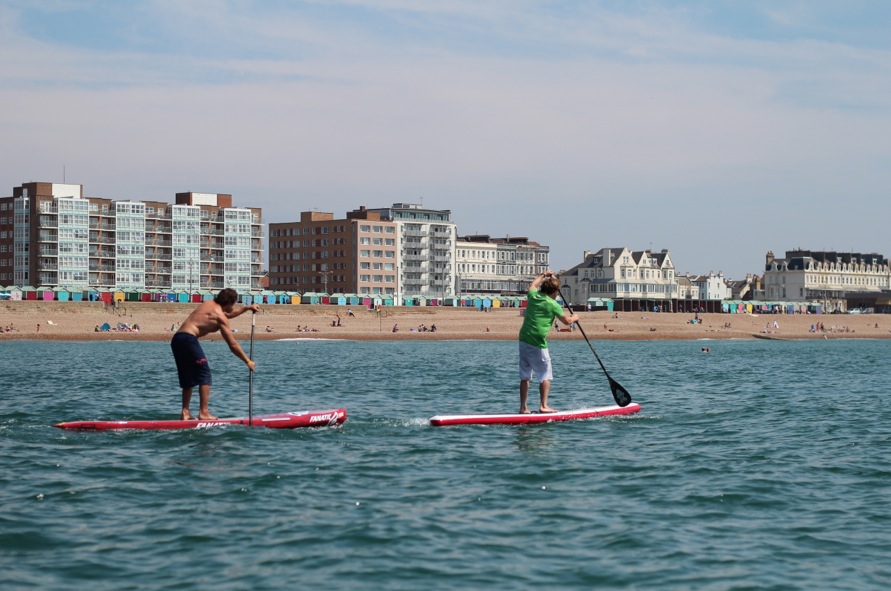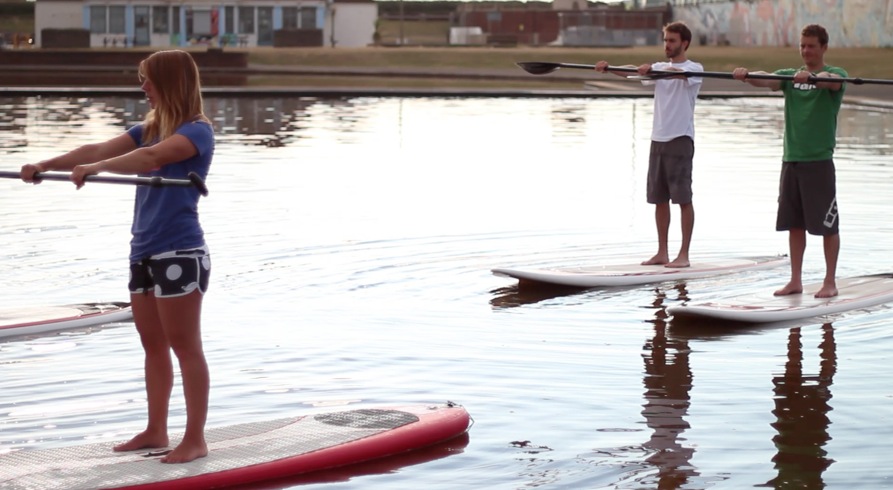
SUPing can require a lot of energy; SUP surfing, down winders and racing are all physically demanding. The health and fitness benefits that we receive from SUPing are very much dependent on what we are doing and how much effort we put in.
Every SUP discipline will work the body slightly differently, using different energy systems and slightly different muscle groups, some being more challenging than others.
As with most physically demanding watersports, SUPing can improve your cardiovascular fitness and general wellbeing. 
What is cardiovascular fitness?
Cardiovascular fitness refers to the ability of the lungs to provide oxygen to the blood, and the circulatory system to transport blood with oxygen and other nutrients to the working muscles for sustained periods of time whilst under stress.
Improving our cardiovascular fitness will benefit us by:
- Increased aerobic capacity
- Increased heart function
- Reduction in blood pressure
- Decreased fat stores
Cardiovascular exercise is a sustained exercise that uses fat stores as its main fuel source. For the first 5-15 minutes (depending on fitness levels) the main fuel being used is carbohydrate (glycogen), as time goes on more oxygen is delivered to the muscles and a switch is made from carbohydrate to fat.
If the main aim of cardiovascular exercise is to burn fat then it is the time that is spent after the initial 15 minutes that is the most important.
Moderate aerobic exercise promotes the expenditure of large amounts of fat and calories that help to achieve weight-loss and fitness goals. Vigorous activity using the anaerobic energy system is effective in expending calories over a shorter period of time and also achieving performance as well as fat loss goals.
To improve our cardiovascular fitness, the American College of Sports Medicine (ACSM) recommends we should:
“Work at 55-90% of your Maximum Heart Rate (MHR), 3-5 days a week for 20-60 minutes – This advice will vary depending on fitness levels.”
A good way to check you are getting a cardiovascular workout whilst paddling is by wearing a heart monitor. This will give you an indication of the type of workout you are getting through your paddling – like with every type of exercise, you get out what you put in!
To ensure that you are getting an effective workout from paddling it’s a good idea to understand how SUPing will work your energy systems, ensuring you are getting the right workout for your goals.
The SUP systems.
When paddle boarding your body is constantly working to supply your muscles with enough energy to keep you going, but the way energy is made available to your muscles changes depending on the specific intensity and duration of your session. SUPing can use both your Aerobic and Anaerobic systems. The energy system our body uses during SUPing depends on the duration and intensity of the session.
Very short duration activities, which are less than 30 seconds of a high intensity, such as the immense effort you put in at the very start of a sprint race, will get energy predominantly from the creatine phosphate system, fuelled by creatine phosphate.
Slightly longer duration SUP sessions, which are less than 2 minutes of a high intensity, such as a very short sprint race, will use energy predominantly from the lactate system fuelled by glucose. This glucose would come from stores in the muscle cells and in the liver. Energy would be required too fast for carbohydrates to be broken down into glucose and then used in this energy system.
Longer duration SUP sessions greater than 2 minutes such as a long distance race, would use energy predominantly from the aerobic system fuelled by carbohydrate and fat. Carbohydrate would fuel the aerobic system for the first 20 minutes and then fat would become the predominant fuel source.
The aerobic system would only be the predominant supplier of energy when the intensity of the activity was low to medium. As soon as intensity increases to a higher level the lactate system would take over again.
Why not mix up your SUP training? Interval training is a great way to mix up your SUP training, keeping it interesting aswell as improving fitness, performance and providing an additional challenge. So why not try a sprint SUP followed by a slower SUP, then repeating. You can then change the distance and duration of the intervals to keep things interesting and challenging!
So YES…
Stand Up Paddle Boarding can improve your cardio fitness if used in the right way with the appropriate effort. If you are looking to improve your fitness through SUP, it is best to speak with a Fitness Professional who can help advise you on a training plan. And make sure you mix up the training with other cardio training such a running, swimming or bike riding.
